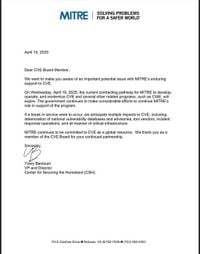As of April 16, 2025, the Common Vulnerabilities and Exposures (CVE) database, a critical resource for the cybersecurity industry, is set to go offline due to the expiration of U.S. government funding. This abrupt cessation of support from the U.S. Department of Homeland Security (DHS) has raised alarms across the cybersecurity community, as the CVE system is widely recognized as the gold standard for cataloging and managing security vulnerabilities.
Yosry Barsoum, Vice President at MITRE Corporation, which has operated the CVE program for over 25 years, issued a stark warning to CVE Board members about the potential fallout from this funding lapse. In a letter circulated on April 16, he stated, "If a break in service were to occur, we anticipate multiple impacts to CVE, including deterioration of national vulnerability databases and advisories, tool vendors, incident response operations, and all manner of critical infrastructure." This statement underscored the gravity of the situation as the cybersecurity landscape faces increasing threats.
The CVE system, maintained by MITRE with funding from the National Cyber Security Division of the DHS, serves as a reference and repository for disclosed cybersecurity vulnerabilities. It has played a pivotal role in helping security professionals track and manage vulnerabilities effectively, with unique identifiers for each flaw, such as CVE-2014-0160 for OpenSSL's Heartbleed and CVE-2017-5754 for Intel's Meltdown.
Experts have expressed deep concern over the implications of the CVE program's potential shutdown. Former CISA head Jean Easterly remarked, "The CVE system may not make headlines, but it is one of the most important pillars of modern cybersecurity. Losing it would be like tearing out the card catalog from every library at once—leaving defenders to sort through chaos while attackers take full advantage." This sentiment reflects the widespread anxiety among cybersecurity professionals who depend on CVEs to communicate about vulnerabilities and coordinate responses.
John Hammond, a researcher at Huntress, echoed these concerns, stating that the security world would lose "the language and jargon" necessary to address its problems if the CVE system were to go offline. He lamented the potential confusion that could arise from the lack of a standardized system for identifying vulnerabilities, a sentiment shared by many in the industry.
Additionally, Dustin Childs, head of threat awareness at Trend Micro's Zero Day Initiative, warned that the consequences of a CVE shutdown would be disastrous. He noted that before the establishment of the CVE system in 1999, there was a confusing array of different terms and classifications for vulnerabilities, leading to significant communication issues. "If MITRE were to lose funding for the CVE, we can expect considerable confusion again until someone else picks up the flag," Childs cautioned.
Despite these dire warnings, the U.S. government has been engaged in a significant cost-cutting campaign, which has raised questions about the future of essential cybersecurity programs. Barsoum's letter indicated that the government is making "considerable efforts" to continue MITRE's role in the CVE program, but the lack of a renewed contract has left many in the cybersecurity community feeling uneasy.
In response to the uncertainty surrounding the CVE program, VulnCheck, a private vulnerability intelligence company, announced on April 15, 2025, that it has proactively reserved 1,000 CVEs for the year. Patrick Garrity, a security researcher at VulnCheck, stated, "We want to take a moment to thank MITRE for its decades of contributions to the CVE program. Given the current uncertainty surrounding which services at MITRE or within the CVE program may be affected, VulnCheck has proactively reserved 1,000 CVEs for 2025." This move aims to ensure that the community and their customers continue to receive timely and accurate vulnerability data.
While the CVE program will remain accessible as a historical document via GitHub, the immediate future of the CVE system remains in jeopardy. The potential for a gap in service could have far-reaching consequences, particularly as the cybersecurity landscape continues to evolve and threats become more sophisticated.
As the expiration of funding looms, the cybersecurity community is left grappling with the reality that without the CVE program, coordination efforts against cyber threats could falter. The CVE system is not just an American resource; it relies on international cooperation, with hundreds of partners from 40 countries contributing to the database. The loss of this collaborative effort would leave many organizations struggling to manage vulnerabilities effectively.
In light of these developments, the urgency for a solution has never been greater. Cybersecurity professionals are calling for immediate action to secure alternative funding or develop a private successor to the CVE database. The stakes are high, and the implications of a disruption to the CVE program could extend beyond the cybersecurity sector, impacting national security and critical infrastructure.
As discussions about the future of the CVE program continue, the cybersecurity community remains hopeful that a resolution can be reached swiftly. The need for a standardized and reliable system for tracking vulnerabilities is paramount, especially as cyber threats continue to escalate in complexity and frequency. The CVE program has been a cornerstone of cybersecurity for decades, and its preservation is essential for maintaining the integrity of the global cybersecurity framework.









